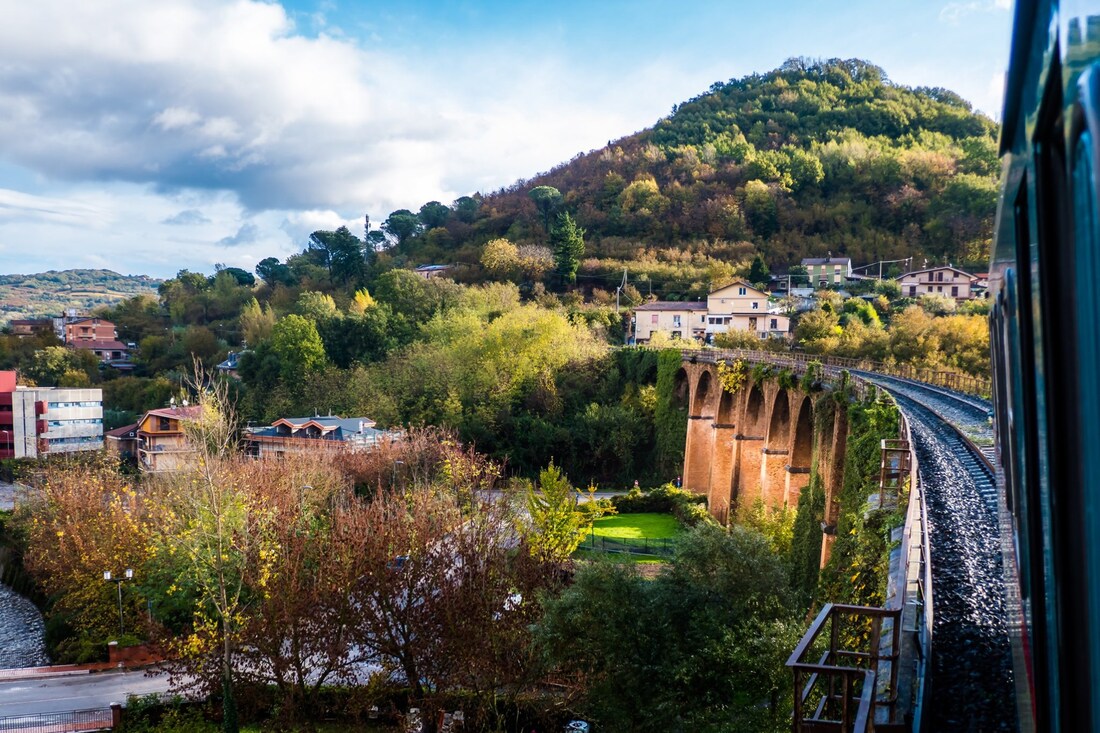|
by Valentina Corvigno, Architect, Carrig Conservation International Ltd. The Avellino-Rocchetta SA railway tells us a story about territory and the construction of its landscape. Completed in 1895, it also tells us about the history of Southern Italy: the railway was a promise Ferdinando Borbone made in 1839 when the first railway ran the Kingdom of the Two Sicilies. With great effort, the railway was built, a wonderful feat considering the very complex orography, bending both, the railway and the terrain, to each other, to making a new landscape. The railway squeezes into the core of Irpinia and moves so slowly that the traveller can enjoy through the window the beautiful landscape at 30km/h. The beautiful view from the train. Source: Sabino Battista You can either have a short trip, visiting just one town – there are about 30 small mostly medieval towns, along the railway, all perched in the Southern Appennines’ hills . Or you can just travel to experience the railroad. A warm and bright day, in a late spring or in an early summer, in September or in mid-October, would be ideal to travel on the amazing historic coaches which are two fascinating ALn668, restored by the skilled technicians of Fondazione FS . The 119km trip takes its departure from Avellino Train Station. Its main building has been rebuilt after the 1980’s earthquake, but in the area few buildings of industrial heritage, dated back to the first layout, still survive: the locomotive shed, the maintenance building, some little houses for railway workers, a railway turntable and a water tower together with the entire railway are now a National Monument, protected by the MiBAC (Ministry of Cutural Heritage in Italy). Several steel and masonry bridges allow the train to jump from end to end of three rivers, which give Irpinia plenty of water for its green landscape. This is the first Historic Railway to receive an official acknowledgement of “National Monument” – the track, tunnels and bridges are protected by law. The train takes the road to Est entering the inner part of Irpinia, crossing the Sabato River, the first of the three rich rivers the railway crosses and follows. We are immediately amazed by the first of many pieces of 19th century engineering: the Milano Bridge. A curved red brick, 16-arches bridge which literally draws the landscape, imposing itself to it (pictured below) The Milano Bridge. Source: Sabino Battista The bridge opens the door to the Irpinian Wine Valleys. Several rows of vines, densely planted make up the unique pattern of the landscape: bright green in spring and summer, a fierce red in late September and October, during the most important moment for our great wines: the “vendemmia” (the harvest of the grapes). Between the two most important wine-areas, Fiano DOCG and Taurasi DOCG, The Prince Bridge can be found. Named “Ponte Principe” (Prince Bridge) for its magnificence, it is a steel and masonry bridge, 300 mt on three spans; it is believed to be the cousin of the Eiffel Tower, as it is made with the same technique and known as the “Horizontal Eiffel Tower”, amongst the locals. The beautiful vineyards which make up the landscape of the Irpinian Wine Valleys. Source: Sabino Battista  The Prince Bridge. Source: Sabino Battista With those valleys behind us, we proceed on our tour towards the wonderful mountains of the Picentini Regional Park. An astonishing biodiversity lives there, flora and fauna grant us gifts of nature like chestnuts and truffles known all over the world. Still moving between woods, rivers and old medieval little towns we descend the mountains to follow the course of the Ofanto River, often the subject of Ancient Roman writers. The River, just born from a water source in the area of the Medieval Town of Sant’Angelo dei Lombardi, runs southeast, firstly into the artificial Lake of Conza, a WWF protected area, forming the border between the Province of Avellino and the Province of Potenza, proceeds towards Puglia to jump into the sea. Our railroad make the exact same way following the river and crossing it with amazing bridges. The end of our tour is Rocchetta SA Railway Station, an historic crossing station where trains from Campania, Puglia and Basilicata meet before heading to their destinations. Everything seems as if it is living in another era, like a still-frame from the late 19th century. Travelling along this road is like travelling through time, meeting nature, monumental and vernacular architecture, local knowledge and practices, rituals, oral traditions. These are all tangible and intangible cultural heritage which we must protect and we must leave as intact as possible to the next generation, so they too can experience this history.
2 Comments
5/14/2020 19:25:06
Articolo interessantissimo. La prossima volta in Italia, andro' alla scoperta dell'Irpinia.
Reply
Maurizio Foligno
5/20/2020 16:05:24
se riesco a trovare una foto di quando la linea era operativa, 1980,con una Aln668 te la invio
Reply
Leave a Reply. |
CARRIG CONVERSATIONS BLOG
We hope to inspire important conversations and debates on the topics of heritage, climate change, sustainability and much more.
CARRIG CONVERSATIONS
PODCAST Archives
July 2023
Categories |
|
T. +353 (0)1 552 9080
E. [email protected] |
VAT IE8240008C
Company Reg. 240008 Directors Peter Cox | Aileen Le Brocquy |





 RSS Feed
RSS Feed